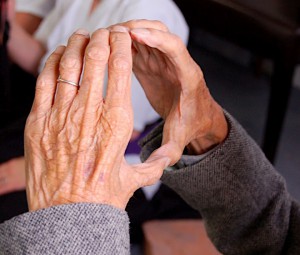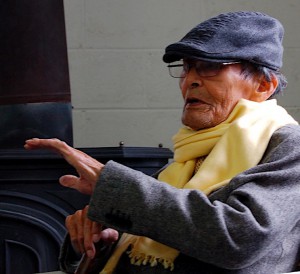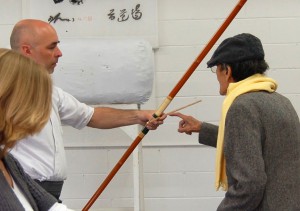Tuesday
Community ArticlesKyudo is Not a Shambhala Art
article by Carolyn Kanjuro
photos courtesy of Sue Kranzdorf
Kyudo, “standing meditation” engaging the warrior’s implements of bow and arrow, has been considered the highest form of samurai training for hundreds of years in Japan. Deeply rooted in Buddhist teachings, aesthetic principles in harmony with nature, and a warrior tradition of unflinching loyalty, this culture captured the inspiration of the Vidyadhara Chogyam Trungpa Rinpoche. Thanks to his determination to bring us an embodiment of these qualities, we have in our midst a twentieth generation master, a national living treasure of Japan, Kanjuro Shibata Sensei.
So, why then, is kyudo not a Shambhala art? Because the very term “Shambhala Art” has come to imply an aesthetic form, something that beautifies our mandala, an adornment, an elective, if you will, for those who have time and inclination left over after their “main” practice and study commitments.
Editor’s Note: We are currently on hiatus from publishing new articles; in the meantime, please enjoy this classic item reprinted from our back issues.
It is an interesting reversal, since kyudo first entered our mandala as an exclusive practice of the court, offered to Trungpa Rinpoche’s son and ministers and only later extended to the community at large. A Sangyum, who spent many hours with Trungpa Rinpoche near the end of his life, brought home something of the bond these two gentlemen shared with these words:
“Near the end, when Rinpoche was so sick he could hardly get out of bed, the one person he would never say ‘no’ to meeting, the one person he would rise, dress up for, and go downstairs to see was Shibata Sensei.”
The Vidyadhara knew whom he had invited wholeheartedly into his court – a warrior with elegance, loyalty, and perseverance, a meditation master of few words and rigorous old style training.
Few words. Perhaps this is part of how kyudo appears to have lost its place in our world.
One evening, fretting to Sensei over whether or not my brief nightly dharma readings constituted enough study to further my understanding of the path, he countered, “Be careful. Too much study closes the heart.”
This reveals much about the nature of the path he transmits. For years, Sensei has seemed quite at ease sharing virtually no common spoken language with his students. He teaches via presence, body to body, heart to heart.
Practicing under the Kyudo Master’s gaze can be terribly claustrophobic. Imagine having your meditation instructor track the movements of your mind as you sit on the cushion, piercing your wandering thoughts with embarrassing accuracy. In sitting practice, your mind can flood and rage, hunger and dream; no one seems to notice. But try holding a long bow and arrow, appearing natural and at ease, while you push and pull with your whole body, attempting to remain in perfect balance, unfettered by hope or anxiety. With or without his direct gaze, there is no escaping one’s flimsy artifices, the habits of mind that have ingrained themselves in the body to protect us from being fully present.
And, of course, one is transparent not only to the Kyudo Master, but to the surrounding practitioners. This leads to a strange sense of intimacy based on very little knowledge of people’s life situations and backgrounds. At the same time, it’s too exposing to support much superficial camaraderie. This brings us to the often disconcerting social aspect of kyudo practice.
If each of Sensei’s ibas (lit. “shooting places”) are mini-experiments in world peace, perhaps this explains the steady dose of warfare. Usually, it’s subtle. The slight steeliness of a student in the face of unwanted correction from a peer. The difficulty of surrendering one’s own rhythm to the group or to the person in front in the shooting line whom we are convinced is moving too fast, too slow, or just too perfectly. The creeping certainty that if this one annoying person were not here today, the whole situation would be clear blue sky.
“Why is this writing so disturbing?” I once asked Sensei of a book that had just come our way.
“The problem is the author likes some people and doesn’t like others,” he answered.
Um, isn’t this true of everyone? Don’t we all like certain people and dislike others? What if our likes and dislikes are truly irrelevant? What if this is all that’s keeping us from world peace, from building an “enlightened society?”
No one looks more invigorated than Sensei himself when his students and the surrounding community come together and manifest a harmonious and productive base – cleaning the Kami tree area at Dechen Choling before a ceremony; sweating profusely while cutting and hauling away the oppressive pines that had been shadowing the shooting range at Karme Choling for years; clearing tons of autumnal debris from his yard in Boulder prompting him to remark with wide-eyed gratitude, “This must be a different kyudo master’s land!”; and, yes, shooting together with earnest attention in moments of unified discipline and grace on the platform.
But he is entirely uninterested in an easy peace born of pacifying rewards for people’s ambitions, stacked to resemble a smoothly operating hierarchy. And he certainly doesn’t make decisions designed to augment or even stabilize his modest salary. Peace with a faulty foundation, based on likes and dislikes, quickly crumbles. He goes for balance. When the form is crisp and tight, but lacking levity, relaxation, and gentleness, he takes it apart. When the students are sloppy or “too sweet”, as he sometimes says, he might deliver a sharp critique or disappear altogether until they come to.
“Target shooting breeds three day monks,” he says. Fixating on hitting the target as a goal makes people quickly give up.
In the moment of greatest exertion, in kai, the point of balance when the yumi (bow) is at full draw, one is instructed to be “light”, to have a soft, open feeling. An enigmatic, powerful point. Perhaps in this lies a key to long, long perseverance. If we push ourselves unreasonably, we cannot avoid burnout. But to relax and open up, to let go of a desired outcome, even in our most intensified moments, brings the possibility of further awakening. Not something made; something discovered.
I don’t have any answers as to where or how kyudo fits tidily into the Shambhala mandala. Perhaps the very uncertainty and awkwardness of the whole question is the irritating grain of sand necessary to polish a pearl. If kyudo were to become part of some cohesive curriculum (as I once thought could have merit) this would surely create as many problems as it might initially appear to solve. No. The beauty of this practice is its barrenness, too. No real promise of anything other than the curiously compelling journey of plowing through layers of self-deception to unearth one’s own dignity. No special titles. No levels to be accomplished. No measurable attainment other than, perhaps, a sense of greater steadiness and perseverance in a journey without end.
It’s a desert of a practice. Exposing. Claustrophobic. Mysterious. Hard to know where you are on the map or if there is a map at all. But as your senses release their grip on nothing and merge into a relentless horizon, ancestral stars come into view. Dry bones of ghosts who gave up urge you on. The poison-medicine of prickly plants and dangerous animals keeps you awake, adaptable. And every so often, a wellspring appears: teachings of the master in drops, rivulets, or a whole raging storm to refresh your inspiration.
People often ask, “What happens when he dies?”
Likely many have not bothered to try the practice simply for assuming it is already twilight, given Sensei’s 90 years of age, not worth the effort going in for something that has no future. Perhaps so. Or perhaps, with the help of his students and the love of the community he continues to tend, he will live to 120 years, as Trungpa Rinpoche predicted. All I know is that right now we have a powerful meditation master, a trained warrior of the heart, living among us, and no time spent learning from him is wasted.
~~
Shibata Sensei just finished teaching a program in Boulder at his home iba. He has plans to travel and teach in Ojai, California in early May and plans to be at Dechen Choling in July. The rest of his schedule for this year has yet to be determined. He has recently passed leadership of his organization, Zenko International, to his son, Kanjuro Shibata XXI, who resides in Kyoto, Japan.








May 14, 2012
Reply
Hi Carolyn!
I agree wholeheartedly with your approach to the conundrum of “dharma art”. While I could split the hair of “art” into something that results in a product available for others to ponder versus art that “is simply the activity of nonaggression” (from the back cover of “Dharma Art” ed. by J. Lief), your article underscores the concept of practicing all the time rather than on the cushion or during a program. Ultimately we are trying to learn to be open always.
I think each paragraph in your article could be its own essay.
Thanks for writing this,
Your Brother Charlie
May 14, 2012
Reply
Feeling groundless, raw, exposed, claustrophobic. And seeing our habitual attempts to make a credential out of it all. Aren’t we funny! Thank you, Caroline, for writing this openhearted and insightful essay. This was one of my favorite parts:
“The beauty of this practice is its barrenness, too. No real promise of anything other than the curiously compelling journey of plowing through layers of self-deception to unearth one’s own dignity.”
May 12, 2012
Reply
Do you know what Shibata Sensei think about vegetarianism ?
May 12, 2012
Reply
Dear Lady Carolyn,
Kudos to accurate , inspired, genuine writing. This portion really makes its mark, and it bears inspired repeating:
“It’s a desert of a practice. Exposing. Claustrophobic. Mysterious. Hard to know where you are on the map or if there is a map at all. But as your senses release their grip on nothing and merge into a relentless horizon, ancestral stars come into view. Dry bones of ghosts who gave up urge you on. The poison-medicine of prickly plants and dangerous animals keeps you awake, adaptable. And every so often, a wellspring appears: teachings of the master in drops, rivulets, or a whole raging storm to refresh your inspiration.”
We indeed are very fortunate, and the day does not go by when we say thank you , thank you , O-Sensei, a thousand times over from places on three continents at least. Yes, Kyudo is not a Shambhala art, it is rather kyu no michi, a path of manifest practice which is offered to our Shambhala mandala , and indeed to all beings, in countless ways beyond concept.
Thank you for this inspiration and generosity. May O-Sensei stay with us and continue to flourish and teach us for a long, long time.May his lineage continue to live and manifest in Shambhala beyond time.
May 12, 2012
Reply
David, Alex, and all, thank you very much for reading and responding.
Alex’s question seems apt for the whole world right now.
Nourished from childhood by the wealth of aesthetics in our mandala, I have nothing but gratitude for all of it. That said, from what I understand, kyudo is not primarily a practice of aesthetics. To place it in that category while we have this living master with us seems a bit like acquiring a gorgeous ivory bracelet and assuming that by wearing it we have absorbed the wisdom of the elephant.
May 11, 2012
Reply
Thank you. It is wonderful to read about Sensei and his teachings, but I must agree with Alex Van Gils, in questioning the approach the article takes towards Shambhala Arts, even in the title.
They do not seem to be “an elective.” I would go so far as to say that Shambhala Art, and Dharma Art are absolutely essential. Shambhala looks the way it does —banners, colors, shrine and textile choices – because of the arts. I’m pretty sure Sakyong Mipham Rinpoche doesn’t view the arts as electives. In a recent talk he said, “A culture can only be called culture when it has the arts.”
His father remarked to a questioner, “Dharma Art is how we’re going to build an enlightened society.”
Elective? No no. Rather the arts are core, distinguishing values of our world.
May 10, 2012
Reply
Thank you Sensei, and thank you, Carolyn. You have echoed what has been in my heart for years.
May 10, 2012
Reply
Thank you for pulling together all the joyful and bittersweet aspects of Kyudo practice, Carolyn, and presenting them in such a way that is natural, coherent and accessible. How did you get inside my heart and express so completely my experience of practicing Kyudo with a Master Warrior, Kanjuro Shibata Sensei?
May 9, 2012
Reply
Thank you.
May 9, 2012
Reply
Thank you for this well-written and beautiful article. For me, it brings up the question, “How might we change the perception of the arts themselves so that even in Shambhala, they are not thought of as ‘an elective, for those who have time and inclination left over after their “main” practice and study commitments?'”
May 9, 2012
Reply
Dear Carolyn,
Thank you so much for this article. I remember Sensei’s visit at Gampo Abbey last fall, bringing with it a wild storm and rainbows, with much inspiration and awe. I was very thankful for this visit.
All of us at the Abbey send our love and deep respect to you and Sensei.
May 9, 2012
Reply
Wonderful article, Carolyn. Thank you. You truly caught the inexpressible power, beauty, and devastatingly egoless quality of kyudo, embodied by the Master Warrior, Kanjuro Shibata Sensei.